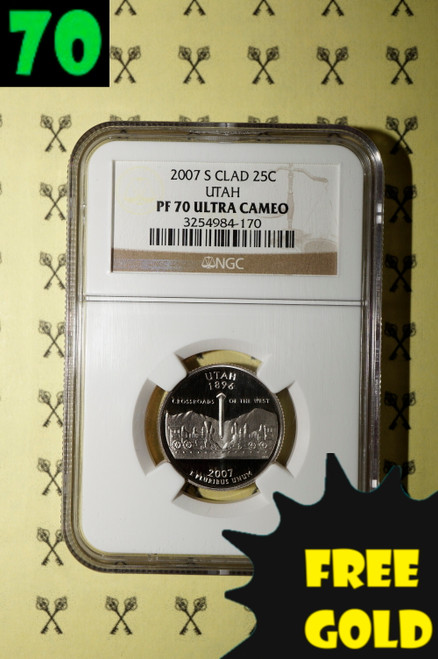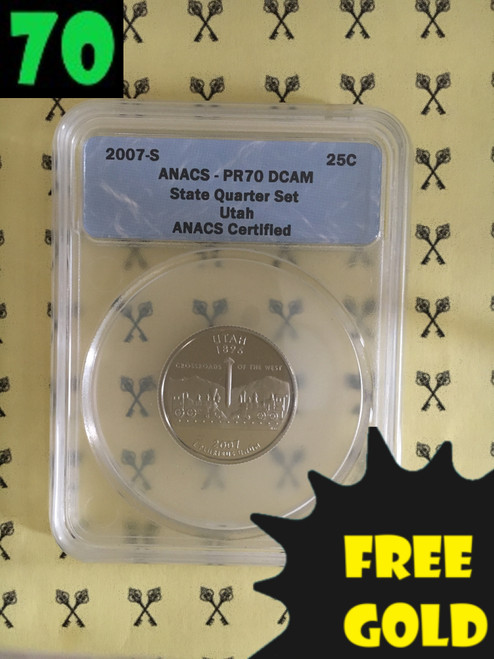-

-

-

-
RESTOCKING

-

-

-

-

-

2007-S Utah Quarter NGC PF 70 Ultra Cameo $50 VALUE with FREE 1/2 GOLDBACK*
MSRP: $50.00$26.57 -

2007-S Utah State Quarter PERFECT ANACS PR70 Deep Cameo with FREE 1/2 GOLDBACK*
MSRP: $50.00$27.57 -
RESTOCKING

-
RESTOCKING

Utah

Utah Half (1/2) Goldback Concept. Click the image to see all available 0.5 Goldbacks for sale.
Utah will get a Half Goldback in 2026
The designs of the Utah Goldbacks will change for 2026. Utah will get a 1/2, 1, 2, 5, 10, 25, 50 & 100 Goldback just like the other new states.
Overview of Utah Goldback Production
The Goldbacks were launched starting with Utah in 2019 and continue through 2025. The UT Goldback series is accepted at these UT locations. Due to the limited initial supply, the 2019 & 2020 Goldbacks are scarce. In 2022 the designs were update with minor changes such as 'voluntary currency' changed to 'negotiable instrument', the 'Aurum' above the note was changed to 'GB' and it now states that Goldbacks are exchangeable for U.S. Gold coin on demand. We also sell Utah coins.
Artistic Interpretations of the Utah Goldback notes
1 - Prudentiae (Prudence)
- Virtue Highlighted:
Prudentiae (Prudence) is represented as a Native American woman symbolizing wisdom and foresight.
- Cultural Representation:
Incorporates elements from Utah's five prominent Native American tribes: Ute, Paiute, Goshute, Shoshone, and Navajo.
- Key Visual Elements:
- Setting: Seated on a sandstone rock beside an ancient bristle-cone pine tree, symbolizing wisdom and endurance.
- Mirror: Symbolizes perspective, hindsight, and learning from experience.
- Copper Bracelet: Shaped like a snake, representing trials and the application of wisdom in decision-making.
- Chipmunk: Represents prudence and preparedness for the future.
- Wolf: Symbolizes the keystone role of prudence in economic stability, paralleling the wolf's ecological importance.
- Bryce Canyon National Park: Features the Natural Bridge formation with Canada geese flying in formation, emphasizing nature and community.
- Quote:
"Deal Prudently" appears as a guiding principle in the artwork.
This piece reflects prudence as foundational to other virtues, emphasizing preparation, wisdom, and perspective.
5 - Veritas (Truth)
- Depiction of Veritas (Truth):
- Represents a Utah pioneer, symbolizing the 1847 migration to the Salt Lake Valley.
- Holds a lantern to symbolize truth shedding light on life’s uncertainties.
- Apron pocket contains a compass pointing West, signifying truth as a moral guide and the settlers' migration westward.
- Holds two books labeled “Judah” (Bible) and “Joseph” (Book of Mormon), highlighting their importance to Utah pioneers' faith and pursuit of religious freedom.
- Symbolic Background Elements:
- Pool and waterfall symbolize the necessity of truth, like fresh water.
- Deer, representing a messenger of truth, drinks from the pool.
- A fish in the stream references Roman symbolism of truth.
- A massive cottonwood tree and an eagle overhead represent stability and freedom enabling truth to thrive.
- The North Star shines as a symbol of truth’s constancy, even when obscured.
- Footing and Barefoot Representation:
- Footing inscription: “Walk in Truth.”
- Barefoot depiction reflects the difficulty of following truth but emphasizes the rewarding destination it leads to.
10 - Justitia (Justice)
- Virtue and Setting:
- Justitia (Justice) is depicted in southern Utah, with iconic red cliffs and Balancing Rock in the background.
- She is dressed in settlers' Sunday best attire, reflecting the time shortly after Utah's settlement.
- Traditional Symbols of Justice:
- Blindfold: Represents impartiality.
- Two-edged sword: Symbolizes the decisiveness and fairness of justice, encompassing both punishment and blessings.
- Scales: Represents balance and fairness. Includes a cross, heart, and anchor to signify faith, hope, and charity as integral to justice.
- Footing: Reads “Judge Righteously.”
- Historical and Natural Symbolism:
- Seagull with a cricket: References the miraculous event where seagulls saved settlers’ crops by eating swarming crickets.
- Desert storm: Represents the divine blessing of rain that ended a drought after settlers’ fasting and prayer.
- Both events highlight justice's merciful and protective aspects.
- Additional Symbolism:
- Sage hen with twelve chicks: Represents mercy and protection, drawing from biblical imagery.
- These elements collectively nod to justice's dual nature of accountability and blessings.
25 - Victoria (Victory)
- Design: The 25 Goldback features the Lady Virtue Victoria (Victory), celebrating women's rights to vote.
- Historical Context:
- The design commemorates Utah's history, as it was the first state where a woman, Seraph Young, cast a vote in 1870.
- Utah became a state with women already voting, while Wyoming granted suffrage a few months earlier.
- Symbolism:
- Victoria holds a banner reading "Votes Counting Since 1870."
- The design highlights women’s firsts in Utah, such as women teaching from the pulpit and Martha Hughes Cannon becoming the first woman state senator in 1911.
- Accompaniment:
- Victoria is shown with a child, symbolizing the role of women in raising future generations and teaching truth.
- The child carries a branch, symbolizing future stewardship of victories.
- Message: The design encourages viewers to "Go on to Victory."
- Backdrop: The mountain view from Alpine, Utah appears in the background.
- Additional Symbols:
- A Chi-Rho Greek symbol on the flag represents Christ's help in the suffrage movement.
- Victoria holds bundled wheat, symbolizing small victories adding up to larger achievements.
- A falcon soars behind her, representing faithful actions and hope.
- Path & Surroundings:
- The straight path with a stone wall represents building good things step by step.
- Aspen trees represent interconnectedness and the importance of women in the human family's heritage.
50 - Libertas (Liberty)
- Libertas (Liberty) is the culmination of the Utah Goldback series.
- Depiction: Libertas is portrayed as a perfected, angelic woman who has fully embraced liberty in her life.
- Symbols:
- Torch in her right hand represents enlightenment.
- Overflowing cup in her left symbolizes the blood of Christ and divine liberty.
- Sheathed sword and shield represent the need to defend and fight for liberty.
- Shield includes the year 1847 (year Utah was settled) and the name Deseret, symbolizing hard work and sacrifice for liberty.
- Honey bee nest on the shield nods to Utah's heritage and the work needed to protect freedom.
- Flanking animals: A mountain lion and a lamb symbolize peace through liberty, inspired by Isaiah 11:6 (lion laying down with the lamb).
- Setting:
- Surrounded by Utah's natural symbols: blue spruce (state tree), sego lily (state flower), and Bear Lake (known as the “Caribbean of the Rockies”).
- The sun rising behind her represents enlightenment and divine blessings leading to perfection.
- Admonition: The phrase “Stand Fast in Liberty” appears at her feet.
History of Gold in Utah
The history of gold in Utah is a story intertwined with the state's broader development, from its early pioneer settlement to its modern mining industry. While not as famously associated with gold as California or Colorado, Utah has a rich history of gold discovery and production. Early settlers, particularly members of the Mormon pioneer groups, encountered gold in various streams and canyons as they established communities. These initial finds, though often small, hinted at the potential for more significant discoveries.
The first notable gold discoveries in Utah occurred in the late 1860s and early 1870s, coinciding with the development of mining in the territory. The Bingham Canyon area, which would later become renowned for its copper production, also yielded significant amounts of gold. Placer mining, where gold is extracted from stream gravels, was common in the early days, with prospectors panning for gold in rivers like the Jordan River and its tributaries. The discovery of lode deposits, where gold is found in veins within rock formations, led to more structured mining operations.
One of the most significant gold-producing areas in Utah was the Mercur District, located southwest of Salt Lake City. Discovered in the late 1800s, Mercur became a boomtown, attracting miners from across the country. The district's gold deposits were low-grade but extensive, making them suitable for large-scale mining operations. The introduction of the cyanide process, a method for extracting gold from ore, revolutionized mining in Mercur and allowed for the profitable extraction of previously uneconomical deposits. The town of Mercur, though now a ghost town, stands as a testament to Utah's gold rush era.
Beyond Mercur and Bingham Canyon, gold discoveries occurred in other parts of Utah, including the Tintic Mining District and the areas surrounding the Uinta Mountains. Though not as prolific as some other western states, Utah's gold production contributed to the state's economic development and attracted settlers seeking their fortunes. Today, while large-scale gold mining continues in Utah, particularly as a byproduct of copper mining in Bingham Canyon, recreational gold prospecting remains a popular activity. The state's rivers and canyons still hold the allure of hidden gold, attracting enthusiasts seeking a connection to Utah's mining history.
The legacy of gold in Utah is a reminder of the state's diverse mineral wealth and its role in the broader history of western mining. From the early pioneer discoveries to the boomtown era of Mercur, gold has played a significant, if often understated, role in Utah's development.